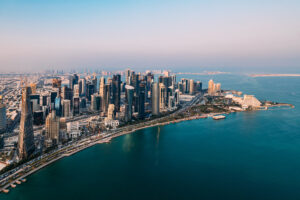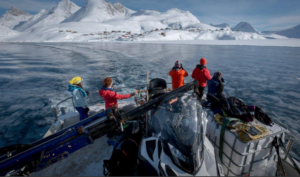Flood risks in Himalayas
Tatopani, Nepal – Before Apa became a legendary Sherpa mountaineer, he was a humble Himalayan potato farmer who worked his fields in the Everest foothills until, without warning, raging floodwaters swallowed his farm.
The flash flood — unleashed when a mountain lake fed by melting glacier waters burst its banks — destroyed homes, bridges and a hydroelectric plant. Apa scrambled up a hill, but at least five neighbors were swept away.
Twenty-six years later, after scaling the world’s highest mountain a record 21 times, Apa is on a quest to draw attention to the danger of more devastating floods as glacial melt caused by climate change fills mountain lakes to the bursting point.
The 51-year-old Apa, who like most Sherpas uses only one name, is trekking the length of Nepal to warn villagers to prepare themselves for change. A third of the way along his 120-day journey, he has already seen many lakes that look ready to spill.
“If it happens again, many villages would be washed away and lives lost,” he said during a break in his trek in Tatopani, a resort village near the Tibet border.Chances are, it will happen again.
There are now thousands of such lakes transforming Himalayan foothills and waterways into extreme danger zones for some of the millions of people in seven countries abutting the massive mountain range.
In Nepal alone, at least 20 of the more than 2,300 glacial lakes are in danger of bursting banks made mostly of rock and scree held together by little more than gravity. Across the wider mountain range, dozens more are building to dangerous levels as temperatures rise and ice melts quicker.
Near Apa’s old home lies Imza Lake, which he used to circle along a track skirting the water’s edge. The trails have long since disappeared underwater.
“Because of the atmospheric warming, most of the lakes are growing very fast,” said Pradeep Mool, an expert in satellite imaging who works assessing glacial melt for the International Center for Integrated Mountain Development based in Nepal’s capital, Katmandu.
Global temperatures went up 0.6 degrees C (1.1 degrees F) during the 20th century, leading into the warmest decade ever recorded in 2000-2009.
“The global community does not seem to understand the problem. The politicians, the media, the scientific communities, they are speaking in different languages about climate change,” Mool said. “But saving these local communities, their lives and their property, should be a primary concern for everyone.”
In 1998, a flood triggered by an ice avalanche that hit Tam Pokhara Lake, south of Everest, killed two people and destroyed six bridges as it cascaded down a riverbed. Seven years earlier, one person was killed when a moraine collapsed into Chuberi Lake northeast of Katmandu, and a 1981 flood unleashed from a Tibetan lake killed at least five people in Nepal.
The midday flood that took Apa’s farm in 1985 left his village of Thame without power and bridges, cutting it off from neighboring towns, markets and schools.
“I was really lucky to have survived,” Apa said. “If it had been at night, we could have been swept away while we were all asleep.” Having to provide for his family, he began carrying tourists’ luggage up the mountains that rose from his backyard. He worked as a porter and then a mountain guide, summiting Everest for the first time in 1989 with a team that included Everest pioneer Edmund Hillary’s son, Peter.
Apa has repeated the feat 20 times since, earning the nickname “Super Sherpa” within the mountaineering community. But every year, it gets more dangerous as the snow and ice that once covered the path melt and shift to reveal loose rock and deep crevasses.
The trekking industry gave Apa a new chance in life, and “I hope the same can happen for the people in other parts of the Himalayan region,” he said.
Apa and his team of climbers and environmentalists are now offering advice to villagers on coping with floods as they trek the 1,060-mile (1,700-kilometer) Nepal stretch of the “Great Himalayan Trail.”
They are asking for help in measuring water levels, and advising those along dangerous waterways to move.
The truth is there is little that poor mountain dwellers can do about the dangers but wait, pray — and if the water breaks — run.
Some communities have installed alarm systems, but they give only a few minutes warning that a flood is on the way, and most villages are too remote for rescue in an emergency.
The lakes themselves cannot all be drained. They are at altitudes too high for heavy machinery to move rocks and carve canals. Some settlements facing imminent flood threat are sending workers uphill into thin air to dig drainage canals with their hands and shovels in hopes of channeling the water away.
Many of the locals are simply too poor to move away from riverbeds, or find leaving their ancestral homeland too painful a prospect. They also need the water for crops and cooking. And the tourists they hope to serve with tea, souvenirs and accommodation travel mostly along roads that line rivers.
It is the Himalayan communities on southern slopes that are most vulnerable, said environmentalist Anil Chitrakar, who helped organize Apa’s trek.
“They are the front line to the mountains,” Chitrakar said. People living there “have to be more resilient … and will have to adapt a way of life that prepares them for change.”
And for locals who stay, there is work to be done, Apa said. New trails must be built for the increasing number of Western tourists, or else the traditional paths to Mount Everest and Annapurna will badly degrade.
Scientists also need new trails to access remote areas and measure lakes and glaciers now out of reach.
“We need to act now and not wait for outside help,” said Apa, who since 2006 has lived in a suburb of Salt Lake City, Utah. He says tourism is the region’s best chance for the future.”Once the tourists come, they will provide these villagers with employment and source of income.”-AP














